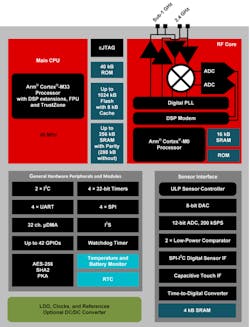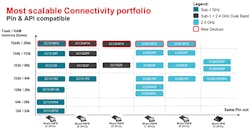Members can download this article in PDF format.
As the IoT evolves into its next iteration, the proliferation of wireless devices will number in the tens of billions. That many devices will require a radically different IoT than we have today, which is being referred to as IoT 3.0.
Next-generation IoT devices will integrate such features as decision-making analytics and require advanced wireless microcontrollers (MCUs) for communications, such as the TI CC13x4/CC26x4 Arm-based family of high-performance MCUs.
These MCUs can support the communications requirements of cybersecurity, cloud and edge computing, machine-to-machine communication protocols, advanced robotics, cognitive computing, and more. They’re fast, scalable, power-intelligent, secure, and field-upgradable. A functional block diagram is shown in Figure 1.
Such MCUs are also protocol and frequency agile, and they can function under any number of protocol stacks and across a wide range of frequencies.
For example, the CC1354R10 SimpleLink MCU supports Bluetooth LE, Matter, Thread, Wi-Sun, Zigbee, Mioty, Amazon Sidewalk, Wireless M-bus, Simplelink, EasyLink, and 6LoWPAN, as well as proprietary platforms yet to be developed. The series handles multiple frequencies, from 287 MHz to 2.5 GHz, and eventually beyond, with front-end sensitivities >100 dBm.
Particularly important will be power consumption. With multiple billions of disaggregated devices all working as a homogeneous, global network, they will need to be power-intelligent and have the ability to manage power dynamically. And when not in operation, they must be able to “sleep” with power consumption in the microamp range. For example, the CC1354R10 MCU has a standby state of < 1.0 µA and a sleep (shutdown) state of 0.17 µA. The CC2674R10 MCU's standby is <1.2 µA and sleep is 0.13 µA.
Getting into the Weeds
What will it take to make innovative MCUs the ideal devices for this next iteration of the IoT? The overarching metric is high performance. Most importantly, they need to process data quickly. They will also have to incorporate a substantial amount of memory to support advanced functions. These MCUs will require their integrated components, such as the sensor controller, radio, and peripheral silicon, to be low power, as well. And they will need to incorporate state-of-the-art security enablers.
High performance is realized via the Arm Cortex-M33 processor. It incorporates 1 kB of programmable flash memory and 8 kB of SRAM. There’s also an additional 256 kB of ultra-low-leakage parity-enabled SRAM for enhanced reliability, if required. If not, 32 kB of this RAM can be freed up for additional code storage. Other performance parameters include an integrated dynamic multi-protocol manager (DMM) driver and a multi-protocol programmable radio.
For security, the MCU includes industry-standard protocols such as secure boot, Arm’s TrustZone, both AES 128- and 256-bit encryption, as well as a public key accelerator. It also has an integrated true random-number generator (TRNG), secure debug lock, and anti-rollback software protection to thwart tampering. Being industry standard means these devices can be used with a wide range of present IoT devices as well as being forward compatible with next-generation devices.
This series features an on-chip, ultra-low-power sensor controller to manage the sensor data. It’s a key enabler since the MCU and the radio consume most of the power during operation. Using a sensor controller that can operate in the microamp range helps keep the power consumption as low as possible.
A unique design feature of this series’ sensor controller is its ability to perform certain functions without using the MCU. Operations such as reading data from a flow meter, motion detector, or thermostat, for example, can be accomplished with just the sensor controller, leaving the MCU in sleep mode. That can reduce the power consumption by up to 90% if the MCU was being used and awakened 100 times per second.
As can be seen, such a design is extremely attractive if the device is doing mostly low-code, simple sensing.
Security
Device security is rapidly becoming the number one concern for IoT devices. Today, IoT devices are among the most vulnerable hardware in the world. It’s also a primary reason for the cautious uptake in both the consumer and commercial segments today.
To deal with security, these MCUs contain a secure partition (it can also be a separate module). This is an isolated memory location separate from the rest of the RAM/ROM. It’s where the cryptographic keys are stored as well as other secure code and operations. Adding TrustZone technology and the TRNG significantly increases security.
However, on the horizon is a technique for even tighter security. MCUs and ASICs for IoT devices will implement a concept known as physically unclonable functions (PUFs). PUFs are primitives in silicon that result from ever so slight, natural variations in the manufacturing process.
These give each chip a unique “fingerprint.” PUFs use these fingerprints to generate a cryptographic key based on that individual chip’s unique characteristics, making cloning or hacking all but impossible. Simply put, a root key is reconstructed from the PUF fingerprint, unique to the chip whenever it’s needed by the system. Look for PUFs to gain rapid popularity in next-generation IoT MCUs.
Dynamic Scalability
Finally, on the must-have side for most engineers is an MCU that can be both scaled and updated. The 13x and 26xx series have that capability (Fig. 2).
Conclusion
Next-generation IoT devices are just around the corner. With IoT 3.0 being disaggregated, devices will have to be significantly more intelligent, secure, and green, and function across a diverse wireless ecosystem. That rests primarily on advanced MCUs and the peripheral hardware to which they’re connected.
The MCUs discussed herein have the necessary design parameters to support the next generation of IoT devices as well as being backward compatible with today’s IoT devices.


